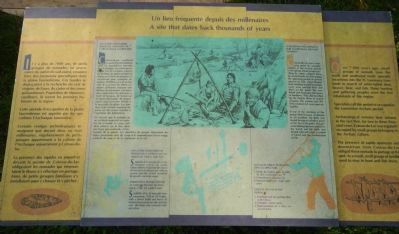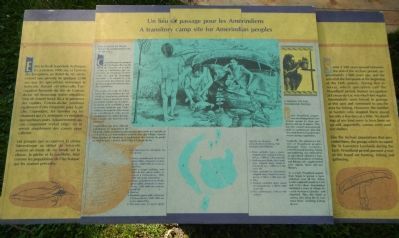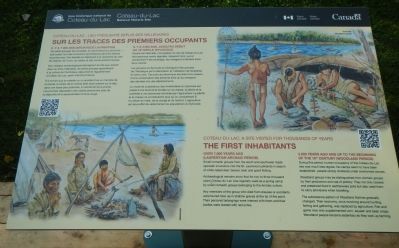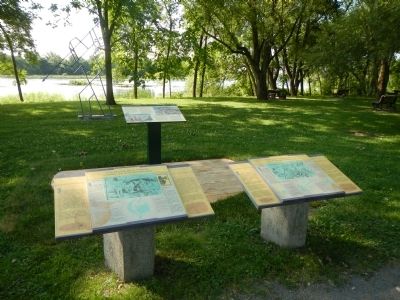Coteau-du-Lac in Vaudreuil-Soulanges, Québec — Central Canada (French-Canadian)
The First Inhabitants
Sur les trances de premiers occupants
Marker One:
English:
Over 7,000 years ago (Laurentian Archaic Period)
Small nomadic groups from the south and southwest made sporadic incursions into St. Lawrence Lowlands in search of white-tailed deer, beaver, bear and good fishing.
Archaeological remains show that for two to three thousand years Coteau-du-Lac was regularly used as a spring camp by small nomadic groups belonging to the Archaic culture.
Any members of the group who died from disease or accidents were buried face up in shallow graves at the tip of the point. Their personal belongings were interred with them and their bodies were dusted with red ochre.
3,000 years ago and up to the beginning of the 16th century (Woodland Period)
During this period, human occupancy of the Coteau-du-Lac site was much less regular. No camps seem to have been established; people simply sheltered under overturned canoes.
Woodland groups may be distinguished from Archaic groups by their production and use of pottery. They not only cooked and preserved food in earthenware pots but also used them to carry provisions when traveling.
The subsistence pattern of the Woodland Natives gradually changed. Their economy, one revolving around hunting, fishing and gathering, was replaced by agriculture. Fish and game now only supplemented corn, squash and bean crops. Woodland people became sedentary as they took up farming.
French:
Il y a 7 000 ans (Archaïque laurentien)
De petits groupes de nomades, en provenance du sud et du sud-ouest, font des incursions sporadiques dans les plaines laurentiennes. Ces bandes se déplacent à la recherche du cerf de Virginie, de l’ours, du castor et des zones poissonneuses.
Des vestiges archéologiques témoignent du fait que, durant deux ou trois millénaires, de petits groupes appartenant à la culture de l’Archaïque séjournèrent régulièrement à Coteau-du-Lac, point d’arrêt printanier.
S’il arrivait que la maladie ou un accident tue un membre de la bande, le corps de a victime était alors enterré sur la dos, dans une fosse peu profonde, à l’extrémité de la pointe. Les proches déposaient des objets personnels près de la dépouille et la saupoudraient d’ocre rouge.
Il y a 3 000 ans, jusqu’au début du 16ᵉ siècle (Sylvicole)
Durant ce intervalle, l’occupation du site de Coteau-du-Lac

Photographed By Barry Swackhamer, August 6, 2014
2. A site that dates back thousands of years Marker
Captions (English / French): Objects found in the burial / Quelques objets retrouves dans le sépulture. 1. Finishing tools for working flint; antler; bone. / Outils de finition pour la taille e silex; andouiller; os. 2. Probably a knife; bone. / Probablement couteau; os. 3. Representation of a face; engraved stone. / Représentation d’un visage; galet gravé.
Amerindian Burial Found at Coteau-du-Lac Dating Back 3 500 to 5 000 Years / Sépulture Améridienne retrouvée à Coteau-du-lac vieille de 3500 à 5000 ans Skeleton of a 41-year old man measuring 1.70 m in height, with a sturdy build and traces of healed fractures on his ribs and left arm. His body was covered with red ochre. / Squelette d’un homme de 41 ans, mesurant 1,70 m, de constitution robuste et portant des traces de fractures cicatrisées aux côtes et au bras gauches. Il était recouvert de poudre minérale rouge.
Amerindian Burial Found at Coteau-du-Lac Dating Back 3 500 to 5 000 Years / Sépulture Améridienne retrouvée à Coteau-du-lac vieille de 3500 à 5000 ans Skeleton of a 41-year old man measuring 1.70 m in height, with a sturdy build and traces of healed fractures on his ribs and left arm. His body was covered with red ochre. / Squelette d’un homme de 41 ans, mesurant 1,70 m, de constitution robuste et portant des traces de fractures cicatrisées aux côtes et au bras gauches. Il était recouvert de poudre minérale rouge.
Les groupes du Sylvicole se distinguent des groupes de l’Archaïque par la fabrication et l’utilisation de récipients en terre cuite. Ces pots de céramique servaient à la cuisson et à la conservation des aliments ainsi qu’au transport des denrées lors des déplacements.
Le mode de subsistance des Amérindiens du Sylvicole et passé d’une économie fondée sur la chasse, la pêche et la cueillette à une économie dominée par l’agriculture. Le pêche et la chasse ne constituèrent plus qu’un complément à la culture du maïs, de la courge et du haricot. L’agriculture eut pour effet de sédentariser les populations du Sylvicole.
Marker Two:
English:
Over 7 000 years ago, small groups of nomads from the south and southwest made sporadic incursions into the St. Lawrence Lowlands in search of white-tailed deer, beaver, bear, and fish. These hunting and gathering peoples were the first inhabitants of this region.
Specialists call this period of occupation the Laurentian Archaic period.
Archaeological remains bear witness to the facts that , for two or three thousand years, Coteau-du-Lac was regularly occupied by small groups belonging

Photographed By Barry Swackhamer, August 6, 2014
3. A transitory camp site for Amerindian peoples Marker
Captions (English / French): Traces of Human Occupation During the Woodland Period. / Des temoins de L’époque du Sylvicole. 1. Point, probably from a spear; found at Coteau-du-Lac; 3 000 to 2 300 years old. / Pointe, probablement de javelot; pierre taillée; retrouvée à Coteau-du-Lac; 3 000 - 2 300 ans avant aujourd’hui. 2. Multi-purpose blade, also a trade item; chipped stone; found at Coteau-du-Lac; 3 000 to 2 300 years old. / Lame à usage multiples, aussi objet de troc; pierre taillée: retrouvée à Coteau-du-Lac; 3 000 - 2 300 ans avant aujourd’hui. 3. Point, probably and arrowhead; chipped stone; found at Coteau-du-Lac; 2 300 to 1 000 years old. / Pointe, probablement de flèche; pierre taillée; retrouvée à Coteau-du-Lac; 2 300 - 1 000 ans avant aujourd’hui. 4. Pike. / Brochet. 5. Pendant; polished stone; found at Coteau-du-Lac; 2 300 to 1 000 years old. / Pendentif; pierre polie; retrouvée à Coteau-du-Lac; 2 300 - 1 000 ans avant aujourd’hui. 6. Pot; earthenware; 15th or 16th century. / Pot; terre cuite; 15ᵉ ou 16ᵉ siècle.
The presence of rapids upstream and downstream fro Coteau-du-Lac obliged these nomads to portage at this spot. As a result, small groups of families used to stop to hunt and fish here.
A Seasonal Encampment for Laurentian Archaic Nomads
Coteau-du-Lac was a stopping point for nomadic peoples of the Archaic period in the spring. Small groups travelling by canoe camped there for several weeks at a time during the spawning period of several species of fish. Cone-shaped tents, housing around ten people each, were pitched here and there on the point. The men fished with harpoons, fish spears or handlines. They also travelled up the Delisle River in search of game. The women and children smoked fish over open-air hearths.
If one member of the group died because of disease or and an accident, his body was buried face up in a shallow grave at the tip of the point. His personal belongings were placed in the burial and the body was dusted with red ochre, a symbol of blood and the continuation of life.
French:
Il y a plus de 7000 ans, de petits groupes de nomades, en provenance du sud et du sud-ouest, venaient faire des incursions sporadiques dans la plaine laurentienne. Ces bandes se déplaçaient à la recherche du cerf de virginie de l’ours, de castor et des zones poissonneuse. Population des chasseurs-cueilleurs, ils furent les premiers habitants de la région.
Cette période d’occupation de la plaine laurentienne est appelée par les spécialistes l’Archaïque laurentien.
Certains vestiges archéologiques témoignent que durant deux ou trois millénaires, régulièrement de petits groups appartenant à la culture de l’Archaïque séjournèrent à Coteau-du-Lac.
La présence des rapides en amont et devant la pointe de Coteau-du-Lac obligeaient les nomades qui empruntaient le fleuve à y effectuer un portage. Ainsi, de petits groupes familiaux s’y installaient pour y chasser et y pêcher.
Un camp saisonnier pour les nomades de l’Archaïque laurentien.
Coteau-du-Lac constituait un point d’arrêt printanier pour les populations nomades de l’Archaïque. Lors de la période du frai des certaines espèces de poisson, de petits groupes se déplaçant à bord de pirogues s’y installaient pour quelques semaines. Plantées çà et la travers de la pointe, les tentes coniques abritaient chacune une dizaine de personnes. Les hommes capturaient les poissons à l’aide de harpons, de foënes ou de lignes dormantes. Ils remontaient aussi la rivière Delisle à la poursuite du gibier. Les femmes et les enfants fumaient les prises sur des foyers installés à l’extérieur des habitations.
S’il arrivait que la maladie ou un accident emportant un membre de la bande, le corps était alors enterré sur le dos, dans une fosse peu profonde, à l’extrémité de la pointe. Les membres du groupe déposaient des objets personnels près du corp et le saupoudraient d’ocre rouge, symbole du sang et de la continuité de la vie.
Marker Three:
English:
Some 2 500 years passed between the end of the Archaic period, approximately 3 000 years ago, and the arrival of the Europeans at the beginning of the 16th century. During that interval, which specialists call the Woodland period, human occupation at Coteau-du-Lac was much less regular. Amerindians were forced to portage at this spot and continued to use the areal for fishing. However, the families or hunters who stopped there stayed only a few days at a time. No dwellings of any kind seem to have been set up and , apparently, canoes were used for shelter.
Like the Archaic populations that preceded them, the groups which occupied the St. Lawrence Lowlands during the Early Woodland period pursued a way of life based on hunting, fishing and gathering.
A Fishing Site for Woodland Peoples
Early Woodland peoples may be distinguished from Archaic groups by their production and use of pottery. They not only cooked and preserved food in earthenware pots but also used them to transport provisions during expeditions.
Gradually, the subsistence pattern of Woodland peoples changed. Their economy, centered around hunting, fishing and gathering, was replaced by an agricultural subsistence base, in which the products of hunting and fishing only supplemented corn, squash, beans and sunflowers.
As a result, Woodland populations began to pursue a more sedentary way of life. When Cartier explored Canada in 1534 and 1535, these Amerindians inhabited a series of villages located between Québec and Montréal. They also fished at various sites along the St. Lawrence River, including Coteau-du-Lac.
French:
Entre la fin de la période Archaïque, il y a environ 3000 ans, et l’arrivée des Européens, au début du 16ᵉ siècle, s’étend une période de quelque 2500 ans qui les spécialistes nomment le Sylvicole. Durant cet intervalle, l’occupation humaine du site de Coteau-du-Lac fut beaucoup moins régulière. Lieu de transit forcé dû à la présence des rapides, Coteau-du-Lac continua également d’être frequenté pour la pêche. Cependant, les familles ou les chasseurs qui s’y arrêtaient n’y restaient que quelques jours. Apparemment, aucun campement n’était érige; on se servait simplement des canots pour s’abriter.
Les groups qui occupèrent la plaine laurentienne au début de Sylvicole avaient un mode de vie fondé sur la chasse, le pêche et la cueillette, tout comme les populations de l’Archaïque qui les avaient précédés.
Une station de pêche pour les Amérindiens du Sylvicole
Ce qui distingue les groupes de l’Archaïque de ceux du début du Sylvicole est la fabrication et l’utilisation par ces deniers, de récipient en terre cuite. Ces pots de céramique servaient à la cuisson et a la conservation des aliments ainsi qu’an transport des denrées lors des expéditions.
Peu à peu, la mode de subsistance des Amérindiens du Sylvicole se transforma profondément. Ceux-ci passèrent d’une économie fondée sur la chasse, la pêche et la cueillette à une économie dominée par l’agriculture, où la pêche et la chasse ne constituaient plus qu’un complément à la culture du mais, des courges, des haricots et du tournesol.
L’agriculture eut pour effet de sédentariser les populations du Sylvicole. Ainsi, un moment des voyages de Cartier au Canada, en 1534 et 1535, ces Amérindiens vivaient dans des villages répartis entre Québec et Montréal et exploitaient des stations de pêche sur tout le Saint-Laurent, dont l’une à Coteau-du-lac.
Erected by Parks Canada / Parcs Canada.
Topics. This historical marker is listed in this topic list: Native Americans.
Location. 45° 17.202′ N, 74° 10.641′ W. Marker is in Coteau-du-Lac, Québec, in Vaudreuil-Soulanges. Marker can be reached from Chemin du Fleuve close to Rue du Fort, on the left when traveling south. Touch for map. Marker is at or near this postal address: 307 Chemin du Fleuve, Coteau-du-Lac QC J0P 1B0, Canada. Touch for directions.
Other nearby markers. At least 8 other markers are within walking distance of this marker. Changes in the landscape (within shouting distance of this marker); The Coteau-du-Lac rapids (about 90 meters away, measured in a direct line); Coteau-du-lac (about 90 meters away); Why a canal at Coteau-du-Lac? (about 90 meters away); The first lock canal in North America (about 90 meters away); The “rigolet” canal (about 90 meters away); The construction of the canal (about 120 meters away); A supply centre / Un poste de ravitaillement (about 120 meters away). Touch for a list and map of all markers in Coteau-du-Lac.
More about this marker. This marker is located at Coteau-du-Lac National Historic Site.
Credits. This page was last revised on June 16, 2016. It was originally submitted on May 30, 2015, by Barry Swackhamer of Brentwood, California. This page has been viewed 273 times since then and 8 times this year. Photos: 1, 2, 3, 4. submitted on May 30, 2015, by Barry Swackhamer of Brentwood, California. • Andrew Ruppenstein was the editor who published this page.

